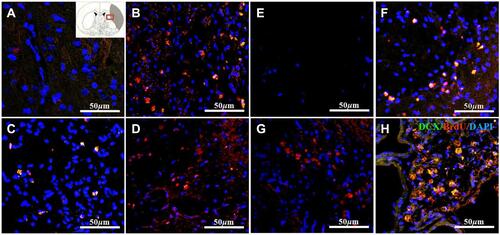Moon SU, Kim J, Bokara KK, et al. Int J Nanomedicine. 2012;7:2751–2765.
The authors have advised on page 2760 is incorrect. Due to an error at the time of figure assembly the images for were duplicated. The authors did not pick this error up during the proof-reading stage of the publication. The correct is shown below.
Figure 5 Doublecortin and bromodeoxyuridine staining was performed to detect the migrating exogenous subventricular zone neural progenitor cells in the hydrophilic or hydrophobic carbon nanotubes transplantation groups (A and D) 3 weeks or (E and H) 5 weeks after middle cerebral artery occlusion injury. The images show (A and E) the experimental control group (without subventricular zone neural progenitor cell transplantation), (B and F) injury-subjected rats transplanted with subventricular zone neural progenitor cells, (C and G) injury-subjected rats transplanted with hydrophilic carbon nanotubes impregnated with subventricular zone neural progenitor cells, and (D and H) injury-subjected rats transplanted with hydrophobic carbon nanotubes impregnated with subventricular zone neural progenitor cells.

The authors apologize for this error and advise that this does not affect the results of the paper.
